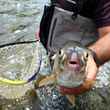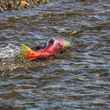It’s late afternoon in early spring and bad weather is coming in quick. The wind picks up as bright sun slides behind dark clouds. I recognize the overpowering signs of wet trouble rumbling down the canyon, but I’m not rowing away from it. Neither should you.
Before the storm
Fair weather fishermen quit when raindrops start to pucker the water’s surface. It’s harder to see risers in the turbulence, but fish still forage in light rain so continue to cast until buckets of water start putting the bugs down. At that point, zip your raincoat, collapse your rod and drop the anchor.
If you’re wearing waders, you won’t need rain pants. If you’re in shorts, they better be quick dry or you need to add rain pants to the ensemble. Jeans won’t dry in the humidity that follows a moisture event.
During the storm
Retreat to the safety of shore if electricity is buzzing around the boat, but drizzle without lightning doesn’t need a takeout. If it’s just a lot of rain in a short amount of time, stay put because when it rains, it pours fish afterward.
Hold in hunker mode while the burst is overhead. Many early spring splashes only last a few minutes then the storm moves downstream. Use the 10-minute time out to rest your casting arm or refuel your empty stomach.
After the storm
When the rain stops, unzip your coat, rig your rod and pull the anchor. Use the first few minutes of your post-storm float to scout rather than cast and keep it slow. Bugs knocked down in heavy storms need a few minutes to dry their wings so there’s no need to hurry. Besides, you want to stay behind the storm not under it.
While scouting, consider the breeze. Chances are, it’s calming down while the water temperature is going up a bit. That’s going to make the bugs dance.
Blue wing olives thrive on gray days. Make sure you have some of those when you’re fishing in rain gear. Midges too. They’re steady even when a spring snowstorm flurries by. Those two bugs are always with me when I’m fishing in the rain, but what I really want is bigger and I watch the banks for it spring through early summer. Salmon flies. Their wings are longer so they need more time to dry than small BWOs and midges. They’re not as graceful either so watch for fliers that look punch drunk on raindrops and you’ll know it’s go time.

My magic moment is usually ten minutes behind the storm when a salmon fly, lacking all the grace of a ballerina, flutters from bush to water. That’s my wings-dry cue. I let out line and start chucking a big bug from the front of the drift boat.
Four casts in and I hook a 22-inch brown trout. I marvel at its spots, like raindrops, along its sides. I quickly let it go then start casting again. I know I’ll catch another one before the drops on my rubber jacket evaporate.
.

































Comments